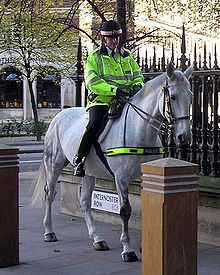
Longman, also known as Pearson Longman, is a publishing company founded in London, England, in 1724 and is owned by Pearson PLC.

Ludgate Hill is a street and surrounding area, on a small hill in the City of London, England. The street passes through the former site of Ludgate, a city gate that was demolished – along with a gaol attached to it – in 1760.

The parish of Trinity Church has three separate burial grounds associated with it in the New York City borough of Manhattan. The first, Trinity Churchyard, is located in Lower Manhattan at 74 Trinity Place, near Wall Street and Broadway. Alexander Hamilton and his wife Elizabeth Schuyler Hamilton, Albert Gallatin, and Robert Fulton are buried in the downtown Trinity Churchyard.
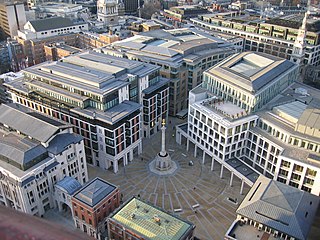
Paternoster Square is a former historic square and now a post-war urban redevelopment, owned by the Mitsubishi Estate, next to St Paul's Cathedral in the City of London. The area, which takes its name from Paternoster Row, once centre of the London publishing trade, was devastated by aerial bombardment in The Blitz during World War II. It is now the location of the London Stock Exchange which relocated there from Threadneedle Street in 2004. It is also the location of investment banks such as Goldman Sachs, Merrill and Nomura Securities, and of fund manager Fidelity Investments. The square itself, i.e. the plaza, is privately owned public space. In 2004, Christopher Wren's 1669 Temple Bar Gate was re-erected here as an entrance way to the plaza.

The Church of St Margaret, Westminster Abbey is in the grounds of Westminster Abbey on Parliament Square, London, England. It is dedicated to Margaret of Antioch, and forms part of a single World Heritage Site with the Palace of Westminster and Westminster Abbey.
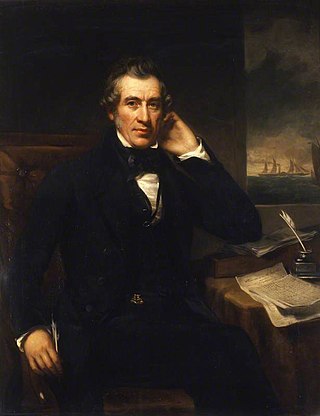
Sir William Fairbairn, 1st Baronet of Ardwick was a Scottish civil engineer, structural engineer and shipbuilder. In 1854 he succeeded George Stephenson and Robert Stephenson to become the third president of the Institution of Mechanical Engineers.
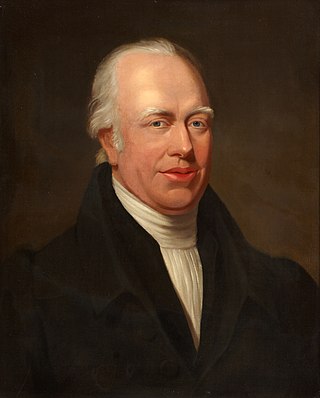
Adam Clarke was a British Methodist theologian who served three times as President of the Wesleyan Methodist Conference. A biblical scholar, he published an influential Bible commentary among other works. He was a Wesleyan.

The Second Great Fire of London in December 1940 was caused by one of the most destructive air raids of the Blitz during World War II. The Luftwaffe raid caused fires over an area greater than that of the Great Fire of London in 1666, leading one American correspondent to say in a cable to his office that "The second Great Fire of London has begun". Fires started by the raid included an incendiary bomb that broke through the dome of St Paul's Cathedral, which was being guarded by a fire watch team at the behest of the Prime Minister Winston Churchill.

John Gellibrand Hubbard, 1st Baron Addington PC, was a City of London financier and a Conservative Party politician.

St Botolph's Aldgate is a Church of England parish church in the City of London and also, as it lies outside the line of the city's former eastern walls, a part of the East End of London. The church served the ancient parish of St Botolph without Aldgate which included the extramural Portsoken Ward of the City of London, as well as East Smithfield which is outside the City.

St Benet Fink was a church and parish in the City of London located on what is now Threadneedle Street. Recorded since the 13th century, the church was destroyed in the Great Fire of London of 1666, then rebuilt to the designs of Sir Christopher Wren. The Wren church was demolished between 1841 and 1846.

Sir John Dodson was an English judge, aka Dean of Arches, and member of parliament.

St Faith under St Paul's in Castle Baynard Ward was an unusual parish within the City of London. It originally had its own building to the east of St Paul's Cathedral, serving as a parish church for the residents of St Paul's Churchyard and Paternoster Row, but this was removed in 1256 to allow for the eastern expansion of the Cathedral. The parishioners were instead given a space to worship within the cathedral crypt.

St Michael-le-Querne, also called St Michael ad Bladum, was a parish church in the Farringdon Within Ward in the City of London. It was destroyed in the Great Fire of London of 1666 and not rebuilt. The name is apparently a reference to a quern-stone as there was a corn market in the churchyard.
Jackson and Walford, later Jackson, Walford, and Hodder from 1861 was a London publishing firm and predecessor firm of Hodder & Stoughton. at 18 St Paul's Churchyard and 27 Paternoster Row in 1871 The publishers with their successive name changes were one of many London publishers that operated around St. Paul's Churchyard and Paternoster Row. They published the Congregational Year Books, which were the publications of the "Congregational Union of England and Wales, and the Confederated Societies." Matthew Hodder apprenticed there from the age of fourteen and became a partner in 1861. Upon the retirement of Messrs. Jackson and Walford in 1868, Thomas Wilberforce Stoughton joined Hodder and the firm was renamed Hodder & Stoughton. The firm then published both religious and secular works and has survived into the present day as an imprint of Hodder Headline.
The Clerical Guide or Ecclesiastical Directory was the earliest ever specialist directory to cover the clergy of the Church of England. In its initial format it appeared just four times – in 1817, 1822, 1829 and 1836, under the editorial direction of Richard Gilbert.
The Artists' Benevolent Fund was instituted in 1810 and incorporated by royal charter on 2 August 1827. It has also been referred to as the Artists' Fund and the Artists' Joint Stock Fund.
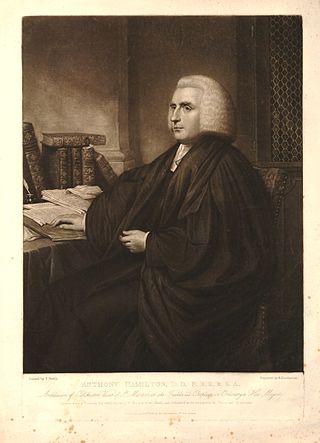
Anthony Hamilton (1739–1812) was an Anglican priest, Archdeacon of Colchester from 1775.

Hugh Mackail, Scottish martyr, was born about 1640 at Liberton, near Edinburgh. His father was Matthew Mackail who was minister at Bothwell before being deprived of his ministry by the government in 1662. At an early age he went to reside with an uncle, Hugh Mackail, one of the ministers of Edinburgh. He entered the University of Edinburgh, studying divinity, where he distinguished himself, graduating, as the records show, in 1658 under Thomas Crawford. Shortly afterward he became chaplain and tutor in the family of Sir James Stuart of Coltness and Goodtrees, then Lord Provost of Edinburgh. In 1661, being then in his twenty-first year, he was licensed by the Presbytery of Edinburgh and afterward preached several times with much success. A sermon which he delivered in the High Church, Edinburgh, in September 1662, in which he declared that "the church of Scotland had been persecuted by an Ahab on the throne, a Haman in the state, and a Judas in the church," gave such offence that a party of horse was sent to apprehend him. He escaped, however, and, after lying concealed in his father's house in Bothwell for some time, retired into Holland, where he improved his time by studying for several years perhaps near Rotterdam. Then, returning to Scotland, he lived chiefly at his father's house, until in November 1666 he joined a rising of the covenanters. After nine days' marching, however, his weak health obliged him to leave the insurgents, and on his way back to Liberton he was arrested, carried to Edinburgh, and committed to the Tolbooth. He was several times brought before the council and tortured with the boot. Finally, after trial, despite the efforts of his cousin, Matthew Mackail, an apothecary, who interceded with James Sharp, archbishop of St. Andrews, on his behalf, Hugh was hanged at the market-cross of Edinburgh on 22 December 1666, amid "such a lamentation," says Kirkton, "as was never known in Scotland before, not one dry cheek upon all the street, or in all the numberless windows in the market-place." According to MS. Jac. V. 7. 22, in the Advocates' Library, "immediately after the execution of the aforementioned four men there came a letter from the king, discharging the executing of more; but the Bishop of St. Andrews kept it up till Mr. Hew was executed," Mackail behaved with great fortitude on the scaffold, addressing the crowd with singular impressiveness. He was buried in Greyfriars churchyard. Wodrow describes him as "universally beloved, singularly pious, and of very considerable learning."
William Gellibrand (1765–1840) was a nonconformist preacher in England who left the United Kingdom at the end of 1823 for Van Diemen's Land. He settled there, with family including his son Joseph Tice Gellibrand, and ran a successful farm and commercial business.
